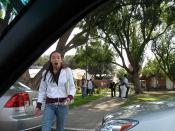Rowley was the dramatist with whom Middleton collaborated most frequently and intensively, their collaboration lasting for years and producing five plays, of which "The changeling" was last, licensed in 1622 and performed in 1624. When I was researching the play online I found lots of speculation over who wrote each scenes ÃÂ it seems, generally speaking, to be accepted (although debateable) that Rowley wrote the beginning and end scenes, as well as the comic sub plot. Most criticism, until around the 1950s, said that the play didnÃÂt work as a whole, and that the sub plot was weak and irrelevant. Swinburne wrote in 1886 that the sub plot was ÃÂvery stupid, rather coarse and almost vulgarÃÂ. A later critic in the 1930s claimed that it could be ÃÂdetached without much damage and the resulting tragedy would stand as one of the most compact and pitiless in this dramaÃÂ.
Part of the problem in reading the sub plot today is that we canÃÂt share the Jacobean appreciation of the comic value of the mentally ill, and to a modern reader it seems distasteful. The sub plot does, however, serve to comment ironically on the central tragic action, providing a pointer for the significance in the main plot: The fools in the mad-house can be seen as grotesque parodies of the characters of the tragic plot. The quite obvious themes of madness in the minor plot serve to highlight the more subtle forms of insanity suggested in the tragic plot, and the sub plot, in general, parallels the main plot in several different ways. IsabellaÃÂs would-be wooers parallel AlonzoÃÂs, AlsemeroÃÂs and De Flores relationship to Beatrice, De FloresÃÂ success compared with Antonio and FranciscusÃÂ failure and AlibiusÃÂs mental defect is his jealous paranoia which in turn is paralleled in...


